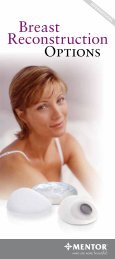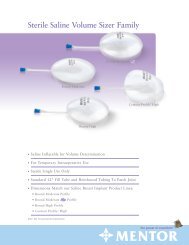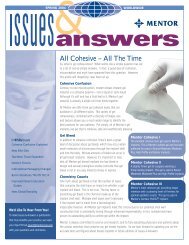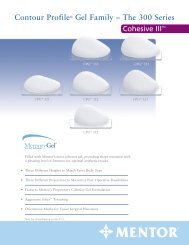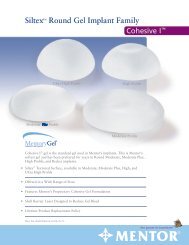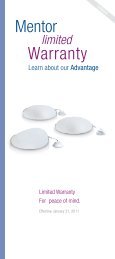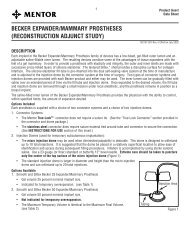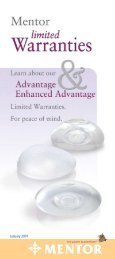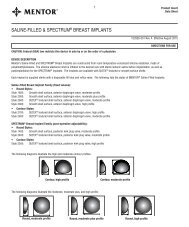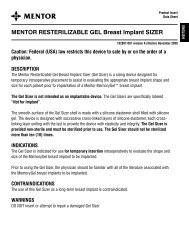Breast Reconstruction Patients Educational Brochure - Mentor
Breast Reconstruction Patients Educational Brochure - Mentor
Breast Reconstruction Patients Educational Brochure - Mentor
- No tags were found...
Create successful ePaper yourself
Turn your PDF publications into a flip-book with our unique Google optimized e-Paper software.
548.7 What are Other Clinical Data Findings?The Study evaluated several possible long-term health effects that have been reported inbreast implant patients. These include rupture, cancer, CTD, CTD signs and symptoms,complications with lactation, reproductive complications, and suicide. These study endpoints,along with others, are being further evaluated as part of additional post approval studies.RuptureIn the MemoryShape <strong>Breast</strong> Implant Core Study, there are 74 primary reconstructionpatients and 37 revision-reconstruction patients enrolled in an MRI cohort study who haveroutine MRI screening of their implants to track rupture (scheduled at 1, 2, 4, 6, 8, and10 years). At 1, 2, 4, and 6 years, the overall follow-up rates for the MRI cohort across allindications were 71% (291 of 411 expected due), 83% (334 of 403 expected due), 72%(279 of 387 expected due), and 56% (212 of 380 expected due), respectively.For primary reconstruction patients in the MRI cohort (N=74), the estimated rate ofsuspected or confirmed rupture was approximately 1.5% through 6 years. This means thatthrough 6 years, an estimated 1 to 2 of every 100 primary reconstruction patients will havea ruptured breast implant. For revision-reconstruction patients (N=37), there have been noreports of rupture through 6 years. The specific estimated rates of suspected or confirmedrupture through 2, 4, and 6 years are presented in Table 10.Table 10Complication Rates for Rupture by Patient in MRI CohortCohort 1 Year 2 Year 4 Year 6 YearPrimary <strong>Reconstruction</strong> 1 , N=74 1.6%(n=1)Revision-<strong>Reconstruction</strong>, N=37 0%(n=0)1.6%(n=1)0%(n=0)1.6%(n=1)0%(n=0)1.6%(n=1)0%(n=0)1One report of a ruptured replacement study implant (primary reconstruction) from the MRI cohortwas not included in the rupture analyses because the patient no longer had the original studyimplant; only original study implants were included in the analyses.Overall, there were 9 suspected or confirmed reports of rupture for 9 of the patientsparticipating in the study, 7 reports among patients in the MRI cohort (4 primaryaugmentation, 1 revision-augmentation, and 2 primary reconstruction patients) and 2 reportsamong patients not in the MRI cohort (1 primary augmentation and 1 revision-augmentationpatient). One report of a ruptured replacement study implant (primary reconstruction) fromthe MRI cohort was not included in the rupture analyses because the patient no longer hadthe original study implant; only original study implants were included in the analyses. Of the 9suspected or confirmed ruptured implants in the overall study, including the 2 that were foundin the non-MRI cohort, 1 case was indeterminate for extracapsular silicone by MRI. Therewere no cases of migrated gel. The rupture rate beyond 6 years in <strong>Mentor</strong>’s MemoryShape <strong>Breast</strong> Implant Core Study continues to be investigated.CancerThere was one primary reconstruction patient and no revision-reconstruction patientswith new diagnoses of breast cancer through 6 years in <strong>Mentor</strong>'s MemoryShape <strong>Breast</strong>Implant Core Study. Four primary reconstruction patients and two revision-reconstructionpatients had a diagnosis of recurrent breast cancer through 6 years. There were no reportsof other new cancers, such as brain, respiratory, or cervical/vulvar in any cohort.Through 6 years, there were no reports of ALCL in any patient cohort in the MENTOR ®MemoryShape <strong>Breast</strong> Implant Core Study.



